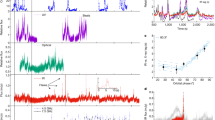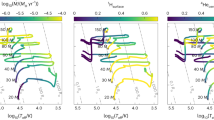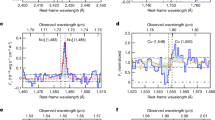Abstract
The brightest known stars in external galaxies are the Hubble–Sandage variables. These are normally assumed to be hot, massive, single stars evolving either towards or off the main-sequence. An alternative model is developed here involving binary mass transfer and accretion on to main-sequence stars. In this case the Hubble–Sandage variables are a third, and presumably final, class of binary in which accretion generates the bulk of the radiation observed. The other two classes are binaries containing an accreting white dwarf (cataclysmic variables)1,2 and an accreting neutron star or black hole (binary X-ray sources)3,4. Accretion disk models developed in these two cases can be scaled directly to treat the main-sequence case. One of the most complex objects in our own Galaxy is the η Carina nebula, rivalling in this respect the Orion Nebula and the Crab. I suggest below that η Can itself is an accreting main sequence star whose explosive outburst in the nineteenth century was caused by runaway mass accretion.
This is a preview of subscription content, access via your institution
Access options
Subscribe to this journal
Receive 51 print issues and online access
$199.00 per year
only $3.90 per issue
Buy this article
- Purchase on Springer Link
- Instant access to full article PDF
Prices may be subject to local taxes which are calculated during checkout
Similar content being viewed by others
References
Bath, G. T., Evans, W. D., Papaloizou, J. & Pringle, J. E. Mon. Not. R. astr. Soc. 169, 447 (1974).
Pringle, J. E. Mon. Not. R. astr. Soc. 178, 195 (1977).
Pringle, J. E. & Rees, M. J. Astr. Astrophys. 21, 1 (1972).
Shakura, N. J. & Sunyaev, R. A. Astr. Astrophys. 24, 337 (1973).
Hubble, E. & Sandage, A. Astrophys. J. 118, 353 (1953).
Humphreys, R. M. Astrophys. J. 200, 426 (1975).
Humphreys, R. M. Astrophys. J. 219, 445 (1978).
Rosino, L. & Bianchini, A. Astr. Astrophys. 22, 453 (1973).
Warner, B. IAU Symp. No. 73, 85 (eds Eggelton, P., Mitton, S. & Whelan, J.A.J.) (Reidel, Dordrecht, 1976).
Bath, G. T., Pringle, J. E. & Whelan, J. A. J. Mon. Not. R. astr. Soc. (in the press).
Kraft, R. P. Astrophys. J. 135, 408 (1962).
Ulrich, R. K. & Burger, H. L. Astrophys. J. 206, 509 (1976).
Kippenhahn, R. & Meyer-Hofmeister, E. Astr. Astrophys. 54, 539 (1977).
Neo, S., Miyaji, S., Nomoto, K. & Sugimoto, D. Publ. astr. Soc. Jap. 29, 249 (1977).
Schwarzschild, M. & Härm, R. Astrophys. J. 128, 348 (1958).
Iben, I. Astrophys. J. 142, 993 (1965).
Stothers, R. Astrophys. J. 138, 1074 (1963).
Bath, G. T. Mon. Not. R. astr. Soc. 182, 35 (1978).
Davidson, K. D. Mon. Not. R. astr. Soc. 154, 415 (1971).
Warren-Smith, R. F., Scarrott, S. M., Murdin, P. & Bingham, R. G. Mon. Not. R. astr. Soc. 187, 761 (1979).
Pagel, B. E. J. Astrophys. Lett. 4, 221 (1969).
Thompson, R. I., Strittmatter, P. A., Erickson, E. F., Witteborn, F. C. & Strecker, D. W. Astrophys. J. 218, 170 (1977).
Lynden-Bell, D. Nature 233, 690 (1969).
Author information
Authors and Affiliations
Rights and permissions
About this article
Cite this article
Bath, G. Accretion powers the brightest stars. Nature 282, 274–276 (1979). https://doi.org/10.1038/282274a0
Received:
Accepted:
Issue Date:
DOI: https://doi.org/10.1038/282274a0
This article is cited by
-
The evolutionary status of eta Car based on historical and modern optical and infrared photometry
Space Science Reviews (1993)
Comments
By submitting a comment you agree to abide by our Terms and Community Guidelines. If you find something abusive or that does not comply with our terms or guidelines please flag it as inappropriate.



